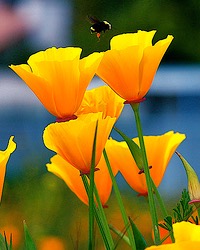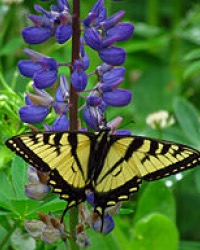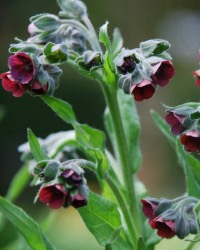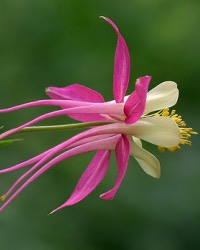In the 1850s, from the gently rolling uplands now called Bennett Ridge in California’s Sonoma County, a man could look from his homesite out to the sea, to Mount Diablo and the Bay, down to the vineyards in the valley and the little town of Glen Ellen.
 In autumn, the leaves of the black oak trees turned golden. The live oaks dropped their share of acorns, assuring the squirrels of a good Christmas, but kept their leaves all year round. The madrones’ bark was mahogany red, and they bore bright berries. The Douglas firs were dark green.
In autumn, the leaves of the black oak trees turned golden. The live oaks dropped their share of acorns, assuring the squirrels of a good Christmas, but kept their leaves all year round. The madrones’ bark was mahogany red, and they bore bright berries. The Douglas firs were dark green.
In the winter, log fires kept the houses cozy and wood stoves kept the pots boiling and heated the ovens where the good-smelling bread was baked. Snow here wasn’t a menace and a burden. It was rare enough to be a marvel, something worth waking the baby for, wrapping him up warmly and taking him out, so he could catch a snowflake.
Shooting stars marked the spring. Not a scrawl of light across the night sky; a wildflower in the grassy meadowlands. The wild iris opened its buds. In the woods where the trees gave shade, the trillim and the hound’s-tooth thrust up through leaf-enriched ground. There were mariposa tulips up here on the Ridge. The Spanish called them “butterfly tulips.” And wild white forget-me-nots, lupine and buttercups in the meadows, columbine and wild strawberry blossoms near the groves of oak, madrone and bay trees. Golden poppies covered the hillside. Now that golden poppy is California’s State Flower. It was just as beautiful then, when it was unofficial.
Apple and pear orchards bloomed, and the days lengthened into summer. Bay trees and fir trees and strawberry blossoms, wine grapes ripening in the sun, made the Ridge a fine-smelling place. Sun in desert country can be an enemy, parching all growing things, including Man. But the summer sun here was agreeable, pleasant, good on the back of a Ridge dweller’s neck, warming the grass barefoot kids played in. Yellow monkey flowers and scarlet Indian paint brushes brightened the slopes.
 Who lived on Bennett Ridge before it was Bennett Ridge, in the days of Spanish rule? There’s no record. Down in Los Guilicos Valley, an English sea captain, John Wilson, who came to California in the 1830s, married into one of the Spanish-American families, became a Mexican citizen, and from then on was John Wilson no longer, but Don Juan Wilson. It’s as well he didn’t live on the Ridge. An Englishman who lets himself be called Don Juan might well bear watching. Stomping heels and clicking castanets and pants fitting like glossy paint were never meant for Winston Churchill. On the Ridge, neighbors had too fine a view to waste their eyes keeping a nervous watch over one another. Their stone walls tell us that.
Who lived on Bennett Ridge before it was Bennett Ridge, in the days of Spanish rule? There’s no record. Down in Los Guilicos Valley, an English sea captain, John Wilson, who came to California in the 1830s, married into one of the Spanish-American families, became a Mexican citizen, and from then on was John Wilson no longer, but Don Juan Wilson. It’s as well he didn’t live on the Ridge. An Englishman who lets himself be called Don Juan might well bear watching. Stomping heels and clicking castanets and pants fitting like glossy paint were never meant for Winston Churchill. On the Ridge, neighbors had too fine a view to waste their eyes keeping a nervous watch over one another. Their stone walls tell us that.
One long, stout, moss-and-lichen-covered wall from the 1860s still stands. It marked the southern boundary of Rancho Los Guilicos, the dividing line between Don Juan Wilson’s holdings and the Ridge. It may well have been built by Indian laborers, or Chinese with their long queues bound around their heads. But there are others, not high enough to keep anyone or anything out or in, put there by Ridge dwellers to mark their own small kingdoms. In some places, these two-stone high walls continue through the woods. Only a man with pride in his home-place would take that much trouble to define it.
Bennett Ridge and Bennett Valley took their name from a family who sent a son to the Assembly in 1853, two years after California entered the Union. In 1865, a government surveyor mapped the Ridge, taking bearings on black oaks and live oaks, setting his markers in mounds of small stones.
 In the 1870s, land transfers began to be set down in the Sonoma County Recorder’s books. Henry Young patented one-hundred-sixty acres of government land on the Ridge in 1877. He already had a smaller holding, one-hundred-twenty-seven acres, but the larger acreage seems for several reasons, to have been his home site. He established his ownership by patent, at a time when many relied on squatter’s rights, gambling on possession’s being nine points of the law, and letting the other point slide. And he apparently planted a grove of cypress trees to grace the approach to his home. Arboreal experts say the trees are ninety years old, and they stand on what were then Mr. Young’s one-hundred-sixty acres. Today’s Ridge dwellers, coming home from the Valley, know they’re near journey’s end when they pass through Henry Young’s cypress grove.
In the 1870s, land transfers began to be set down in the Sonoma County Recorder’s books. Henry Young patented one-hundred-sixty acres of government land on the Ridge in 1877. He already had a smaller holding, one-hundred-twenty-seven acres, but the larger acreage seems for several reasons, to have been his home site. He established his ownership by patent, at a time when many relied on squatter’s rights, gambling on possession’s being nine points of the law, and letting the other point slide. And he apparently planted a grove of cypress trees to grace the approach to his home. Arboreal experts say the trees are ninety years old, and they stand on what were then Mr. Young’s one-hundred-sixty acres. Today’s Ridge dwellers, coming home from the Valley, know they’re near journey’s end when they pass through Henry Young’s cypress grove.
Mr. Parker Talbot, whose firm hand and sprightly style make it hard to believe that he was born in Bennett Valley in 1882, remembers Patrick Riley, who raised a family on the Ridge. According to Mr. Talbot, he “milked a few cows, making butter, raised some wine grapes. Also he and his sons chopped oak trees into firewood that they hauled to Santa Rosa with horses and sold for $5 a cord.” Woodcutting was a source of revenue throughout the area, and two stone foundations of what seem to have been wood-cutters’ cabins stand today. Mr. Talbot says, too, that nearly everyone in the early days planted wine grapes with cuttings obtained from the Mission at Sonoma, and sold the grape harvest to Isaac De Turk, a local vintner, whose wine found “a ready market in San Francisco.” Olives were grown, too, to sell, to pickle for home use.
The grove of black walnut trees set out by an early Bennett Ridger seems to have been planted more to make beauty, and possibly to have pickled walnuts to go with the pickled olives, than to make money.
 Business ventures on Bennett Ridge were relaxed, gentle, even fun. Cobblestones, whacked out of pocket-sized quarries by Italian stonecutters, who paid the landowners by the piece, were horse-hauled in stone “boats” or sleds down to Glen Ellen, and went by train from there to help pave Santa Rosa and San Francisco. These cobblestones and the wine grapes for Mr. De Turk’s winery were Bennett Ridge’s chief commercial products. The horses which pulled the stone boats along the narrow dirt roads wore a rainbow arch of bells about their necks, each bell pitched differently. The Italian stonecutters sang and the horses jingled out chords.
Business ventures on Bennett Ridge were relaxed, gentle, even fun. Cobblestones, whacked out of pocket-sized quarries by Italian stonecutters, who paid the landowners by the piece, were horse-hauled in stone “boats” or sleds down to Glen Ellen, and went by train from there to help pave Santa Rosa and San Francisco. These cobblestones and the wine grapes for Mr. De Turk’s winery were Bennett Ridge’s chief commercial products. The horses which pulled the stone boats along the narrow dirt roads wore a rainbow arch of bells about their necks, each bell pitched differently. The Italian stonecutters sang and the horses jingled out chords.
The demand for cobblestones tapered off in the 1900s, and Prohibition censored the grapes, but the Ridge still offered a serene and beautiful place on which to build a house and raise a family, and then later to welcome that family’s family.
In 1963, the Views Land Company bought from Tom and Kathleen Plant the land which makes up Bennett Ridge Properties. It includes the land patented by Henry Young in 1877, Patrick Riley’s home place, and acreage patented by William Mather as recently as 1915. Mr. Mather’s purpose is spelled out on his application: “To secure homesteads to actual settlers on the public domain.”
Lichen, which have a long life, grow just enough each year to make accurate measurement possible, and stick loyally to the rock they start on, are reliable gauges of the passing of time. The lichen on Bennett Ridge’s long boundary wall and its two-stone high walls; Mr. Young’s cypress grove; the black walnut trees; pear and apple trees from the old orchards; even some veteran grape vines; a road; a house foundation; a well—attest to the presence on Bennett Ridge of these actual settlers, over a ninety year span.

Modern roads and bridges have devalued the mile. Now communication is instant, stoves are clean and know how to turn themselves off, and there’s always plenty of hot water. And ice. On Bennett Ridge, a house is being built from the basalt blocks which have always been there. One of the Ridge’s mini-quarries will be its swimming pool. Henry Young’s cypress grove is not far away. On a Bennett Ridge terrace, a round pool was made from a wine vat. The trees still stand. The air is clean. Nothing has disturbed the peace or shattered the quiet.
In the 1960s, from the gently rolling uplands called Bennett Ridge in California’s Sonoma County, a man can look from his homesite out to the sea, to Mount Diablo and the Bay, down to the little town of Glen Ellen. He can enjoy the good warmth of the summer sun, knowing that in the fall the oak leaves will turn gold, the acorn harvest won’t disappoint the squirrels, the winter will be mild, and in the spring wild flowers will carpet the meadows.
In spring and summer the fields and meadows of Bennett Ridge abound in wildfiowers. A few of the many varieties have been illustrated here in the following order:
- California Poppy
- Lupine
- Houndstooth
- Forget-me-not
- Columbine